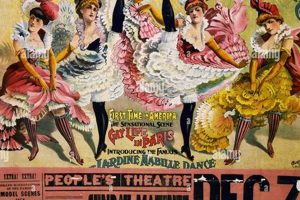Artistic advertisements originating from France, typically produced between the late 19th and mid-20th centuries, showcasing diverse products, events, and cultural phenomena. These graphic designs were initially created using lithographic printing techniques, often featuring vibrant colors and bold typography. Iconic examples include advertisements for bicycles, travel destinations, and theatrical performances.
These historical artifacts offer a unique window into the past, reflecting the aesthetic sensibilities and social values of their time. The designs are valued for their artistic merit, historical significance, and ability to evoke a sense of nostalgia. They serve as tangible links to a bygone era, representing periods of significant technological and cultural advancement. Furthermore, collecting and preserving these items contributes to the safeguarding of artistic heritage for future generations.
The subsequent sections will explore the evolution of graphic design during this period, notable artists who contributed to this medium, and the impact of these artistic creations on modern advertising and design principles.
Guidance on the Acquisition and Preservation of French Period Advertisements
The following guidelines offer insight into the responsible acquisition, proper care, and thoughtful display of authentic printed advertisements from France’s past.
Tip 1: Authenticity Verification: Prior to purchase, meticulously examine the item for indications of age, printing technique (lithography, pochoir, etc.), and paper stock consistent with the purported era of origin. Consultation with an expert is advisable.
Tip 2: Condition Assessment: Evaluate the items physical state. Note any tears, creases, fading, or foxing. Such imperfections impact valuation. Consider professional restoration for significant damage.
Tip 3: Provenance Research: Investigate the history of ownership and origin. Documentation adds value and assures authenticity. Trace the item back to its original source or distributor when possible.
Tip 4: Storage Protocol: Employ acid-free materials for storage and framing. Environmental controls, maintaining consistent humidity and temperature, are critical. Protect from direct sunlight exposure to mitigate fading.
Tip 5: Display Considerations: Utilize UV-protective glazing when displaying the piece. Proper mounting techniques, ensuring even weight distribution, will prevent future damage.
Tip 6: Conservation Practices: Gentle cleaning with appropriate archival materials, handled by a professional conservator, can remove surface dirt without harming the underlying print. Avoid harsh chemicals or abrasive methods.
Tip 7: Documentation and Insurance: Maintain a detailed record, including photographs, provenance information, and a valuation appraisal. Secure appropriate insurance coverage against loss or damage.
Adhering to these recommendations ensures that the value, both intrinsic and monetary, of these cultural artifacts is preserved, promoting their longevity and appreciation.
The concluding sections will address the aesthetic influence of these artifacts on contemporary design and their ongoing relevance in todays visual culture.
1. Lithographic Technique
The prevalence of “vintage french posters” is intrinsically linked to the widespread adoption and refinement of lithographic printing techniques during the late 19th and early 20th centuries. This technological innovation provided artists and printers the means to produce large-format, color advertisements in mass quantities, a feat previously unattainable with older printing methods. The process involved drawing an image with a greasy crayon onto a smooth limestone surface, treating the stone with chemicals to create ink-receptive and ink-repellent areas, and then transferring the image to paper. This method was particularly well-suited to capturing the artistic styles popular at the time, such as Art Nouveau, due to its ability to reproduce delicate lines and subtle tonal variations.
The utilization of lithography enabled artists like Jules Chret and Henri de Toulouse-Lautrec to create visually striking and commercially successful pieces. Chret, often regarded as the “father of the modern poster,” mastered the three-color lithographic process, allowing him to achieve a wide spectrum of hues and create visually dynamic images for Parisian theaters and cabarets. Toulouse-Lautrec, known for his depictions of Montmartre nightlife, similarly exploited the technique’s potential to capture the energy and atmosphere of the era. The impact of lithography extended beyond artistic expression; it democratized art by making it accessible to a broader audience, transforming the streets of Paris into open-air art galleries.
Understanding the lithographic technique is crucial to appreciating the aesthetic qualities and historical context of these artifacts. Recognizing the hallmarks of this process, such as the characteristic texture and layering of colors, aids in authenticating and dating pieces. This knowledge also informs conservation efforts, as different printing techniques require specialized preservation methods. Consequently, lithography was not merely a technical process but a defining factor in the creation, dissemination, and enduring legacy of “vintage french posters”.
2. Art Nouveau Influence
The prevalence of Art Nouveau aesthetics within period French advertising is undeniable, serving as a defining characteristic of many visual compositions. The style, flourishing roughly from the 1890s to the 1910s, profoundly impacted artistic output, manifesting as flowing, curvilinear forms, organic motifs drawn from nature, and a distinct emphasis on decorative elements. This influence shaped advertising, transforming it from mere product announcements into artistic expressions. The style’s visual vocabulary became synonymous with a certain brand of modernism and sophistication, directly appealing to a rapidly evolving consumer culture. The adoption of Art Nouveau was a deliberate choice, aimed at elevating the status of commercial messages and imbuing them with artistic value, enhancing their memorability and impact.
Numerous examples demonstrate this connection. Alphonse Mucha’s theatrical advertisements for Sarah Bernhardt, with their elaborate floral borders, idealized female figures, and sinuous lines, epitomize Art Nouveau’s application in advertising. Similarly, the works of Jules Cheret, often incorporating swirling forms and vibrant colors, demonstrate the style’s inherent suitability for capturing movement and excitement. The choice of typefaces, frequently custom-designed with flowing, organic letterforms, further reinforced the aesthetic unity of these pieces. The effect of Art Nouveau was to create visually captivating pieces, blurring the boundaries between commercial communication and fine art, making advertising an integral part of the urban landscape.
Understanding Art Nouveau’s role is crucial for interpreting these historical visual documents. Recognizing the defining features of this style provides insight into the cultural values and artistic preferences of the era. Appreciation for this interplay between art and commerce enhances comprehension of their historical significance and informs conservation efforts. The stylistic connection underscores the posters enduring appeal and its continued relevance within the field of graphic design, illustrating the enduring power of artistic movements to shape the visual language of advertising and consumer culture.
3. Advertising Innovation
The evolution of “vintage french posters” is inextricably linked to significant advances in advertising strategies during the late 19th and early 20th centuries. The emergence of mass production and the growth of urban populations created a need for more effective methods of reaching potential consumers. These visually arresting designs represented a departure from traditional advertising formats, employing bold graphics, memorable slogans, and artistic sensibilities to capture public attention. The posters served as a crucial medium for promoting a wide array of goods and services, from bicycles and beverages to theatrical performances and travel destinations. The innovative use of imagery and typography directly impacted consumer behavior, shaping brand recognition and driving sales. The posters importance lies not only in their artistic merit but also in their role as instruments of commercial persuasion.
Several specific innovations are evident in period advertisements. The utilization of celebrity endorsements, for instance, can be seen in posters featuring prominent actresses or sports figures endorsing products. The creation of distinctive brand characters, such as “Bibendum” for Michelin tires, served to personify companies and foster consumer loyalty. Furthermore, the strategic placement of designs in public spaces transformed urban environments into vibrant advertising galleries, ensuring maximum visibility and impact. An illustrative example is the proliferation of advertisements for the Moulin Rouge, which leveraged bold imagery and eye-catching typography to attract tourists and patrons. These techniques, considered groundbreaking at the time, laid the foundation for modern advertising practices.
Comprehending the innovative advertising strategies embedded within such designs is vital for appreciating their lasting influence on visual communication. The principles of effective design, memorable messaging, and targeted audience engagement, as exemplified by these posters, continue to inform contemporary advertising campaigns. Recognizing the interplay between artistic expression and commercial intent allows for a deeper understanding of the socio-economic forces that shaped both the advertising industry and visual culture. The challenges involved in studying vintage advertisements relate to preserving their physical integrity and accurately interpreting their cultural context. Their influence extends to graphic design, branding, and marketing, demonstrating the enduring power of innovative advertising techniques to shape consumer behavior and cultural values.
4. Social Commentary
French period advertising, while ostensibly promoting products and services, frequently served as a subtle yet potent form of social commentary. These artworks reflected, and sometimes subtly critiqued, the prevailing social norms, political ideologies, and cultural values of the era. The advertisements often depicted idealized representations of society, highlighting aspirations, anxieties, and shifts in societal structures. Examination reveals underlying narratives about class distinctions, gender roles, technological advancements, and the evolving dynamics of urban life. The messages encoded within these posters, though not always overt, provide valuable insights into the complexities of the past. Understanding the social commentary embedded in these designs enhances their historical significance, transforming them from mere marketing tools into cultural artifacts.
Illustrative examples demonstrate the connection between advertising and social discourse. Many designs reflected the burgeoning consumer culture and the allure of modernity, showcasing new technologies and lifestyle aspirations. Posters promoting bicycles, for instance, often depicted women enjoying newfound freedom and mobility, challenging traditional gender roles. Similarly, advertisements for travel destinations frequently presented idealized images of leisure and escape, reflecting the growing accessibility of travel for the middle class. In other instances, advertising implicitly reinforced existing social hierarchies, portraying different classes in distinct roles and settings. Analysis of imagery, text, and underlying assumptions unveils the subtle ways in which advertisements mirrored and shaped societal attitudes. A more direct form of social commentary is shown in war time posters that directly encourage people to participate in war effort.
The identification and interpretation of social commentary is vital for a comprehensive understanding of period advertising. Such understanding enables a richer, more nuanced perspective of historical context. It enhances appreciation for the nuanced ways in which visual communication can both reflect and influence societal values. Careful attention to the visual and textual elements of these artistic commercial designs reveals their potential to express or reinforce complex messages about social change. By recognizing the social commentary, these posters become significant sources for scholars, historians, and anyone interested in the interplay between art, advertising, and society.
5. Collectibility Value
The collectibility of period French advertising significantly influences the market value and preservation efforts of these artifacts. Their desirability as collectibles stems from a combination of factors, including historical significance, artistic merit, rarity, and condition, all of which contribute to their appeal among collectors, institutions, and investors. This value shapes not only the economic landscape surrounding these works but also dictates how they are preserved and studied.
- Rarity and Scarcity
The number of surviving examples directly impacts collectibility. Designs produced in limited quantities or those that have been lost to time command higher prices. Rare variants, first editions, or pieces printed with errors often become highly sought after. For instance, early advertisements by artists like Toulouse-Lautrec, of which few copies remain, are particularly valuable. The perception of scarcity drives demand and elevates the market value of these items.
- Artist Notoriety and Provenance
The artist significantly influences market value. Works by renowned figures, such as Alphonse Mucha or Jules Chret, attract greater interest and higher prices than those by lesser-known artists. Provenance, the documented history of ownership, adds to the appeal and assurance of authenticity, impacting market value. A design with a verifiable history, particularly one associated with a prominent collector or institution, becomes more desirable.
- Condition and Preservation
The physical condition of a design is a critical determinant of its collectibility. Pieces in excellent condition, free from significant damage, fading, or restoration, command premium prices. Conservation efforts aimed at preserving the integrity of the original design enhance its market value. Restored items, while potentially more visually appealing, may be valued differently based on the quality and extent of the restoration work.
- Historical and Cultural Significance
Designs that reflect important historical events, cultural trends, or social movements are of particular interest to collectors. These pieces serve as tangible links to the past, providing insights into the values, attitudes, and aesthetics of a bygone era. Those advertising iconic events, such as the opening of the Moulin Rouge, or the emerging popularity of bicycles, are prized for their historical and cultural relevance. These pieces often become part of museum collections or private holdings dedicated to preserving cultural heritage.
These factors collectively determine the market for period French advertising. High prices incentivize preservation efforts and contribute to the recognition of these works as significant cultural assets. The ongoing interest in collecting ensures the continued study, appreciation, and conservation, furthering the recognition of their artistic, historical, and cultural contributions.
Frequently Asked Questions About French Period Advertising
The following provides answers to common inquiries regarding printed advertisements originating from France during its artistic age.
Question 1: What defines a genuine piece from its period?
Authenticity hinges on factors such as printing technique (lithography, pochoir), paper stock, and aging characteristics consistent with the purported era of origin. Consultation with experts is advisable.
Question 2: How should items be properly stored and displayed to prevent deterioration?
Storage and display require acid-free materials, UV-protective glazing, and environmental controls maintaining consistent humidity and temperature. Direct sunlight exposure should be avoided to mitigate fading.
Question 3: Is professional restoration advisable for damaged pieces?
Restoration should be considered for significant damage impacting the item’s structural integrity or visual appeal. This should be undertaken by qualified conservators specializing in paper-based artifacts.
Question 4: What factors influence the financial value of these artifacts?
Market value is influenced by artist notoriety, rarity, condition, historical significance, and provenance (documented history of ownership). Pieces with verifiable provenance command higher prices.
Question 5: How did Art Nouveau manifest influence these commercial artworks?
Art Nouveau influence is evident through flowing lines, organic motifs, and decorative elements. This style imbued commercial messages with artistic value and aesthetic appeal.
Question 6: In what ways did advertising during this period reflect social norms and values?
Advertisements often mirrored societal attitudes towards class distinctions, gender roles, and technological advancements. Analysis of imagery and text reveals subtle commentary on social trends.
Knowledge of authenticity verification, preservation practices, and market dynamics aids in responsible collection and appreciation of these cultural artifacts. The unique insights they offer into social values, artistic influence, and innovative advertising, shape their enduring value.
The subsequent sections will elaborate on the legacy of “vintage french posters” in contemporary design and popular culture.
Enduring Legacy
Throughout this exploration, the multifaceted significance of period French advertising has been examined. From their genesis in lithographic innovation and their embodiment of the Art Nouveau aesthetic to their pioneering role in advertising strategies and their capacity to reflect social commentary, these designs represent a pivotal moment in visual culture. Their collectibility ensures continued preservation and study, fostering deeper appreciation for their artistic and historical relevance.
These artifacts continue to inspire contemporary designers and marketers, serving as a reminder of the power of visual communication to shape perceptions, influence behavior, and reflect cultural values. As these works endure, it is essential to recognize their complex and influential impact on advertising, art, and the broader fabric of societal life.







